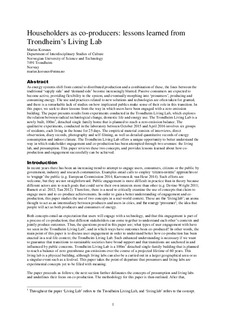| dc.contributor.author | Korsnes, Marius | |
| dc.date.accessioned | 2017-11-21T12:59:29Z | |
| dc.date.available | 2017-11-21T12:59:29Z | |
| dc.date.created | 2017-06-20T14:54:29Z | |
| dc.date.issued | 2017 | |
| dc.identifier.citation | Eceee ... summer study proceedings. 2017, 831-839. | nb_NO |
| dc.identifier.issn | 1653-7025 | |
| dc.identifier.uri | http://hdl.handle.net/11250/2467366 | |
| dc.description.abstract | As energy systems shift from central to distributed production and a combination of these, the lines between the traditional ‘supply side’ and ‘demand side’ become increasingly blurred. Passive consumers are expected to become active, providing flexibility to the system, and eventually morphing into ‘prosumers’, producing and consuming energy. The use and practices related to new solutions and technologies are often taken for granted, and there is a remarkable lack of studies on how implicated publics make sense of their role in this transition. In this paper, we seek to draw lessons from the way in which users have been engaged with a zero emission building. The paper presents results from experiments conducted in the Trondheim Living Lab, which explores the relation between radical technological change, domestic life and energy use. The Trondheim Living Lab is a newly built, 100m2 , detached single family home that is planned to reach a zero emission balance. The qualitative experiments, conducted in the laboratory between October 2015 and April 2016 involves six groups of residents, each living in the house for 25 days. The empirical material consists of interviews, direct observation, diary records, photography and self-filming, as well as detailed quantitative records of energy consumption and indoor climate. The Trondheim Living Lab offers a unique opportunity to better understand the way in which stakeholder engagement and co-production has been attempted through two avenues: the living lab, and prosumption. This paper reviews these two concepts, and provides lessons learned about how coproduction and engagement successfully can be achieved. | nb_NO |
| dc.language.iso | eng | nb_NO |
| dc.publisher | European Council for an Energy Efficient Economy, ECEEE | nb_NO |
| dc.relation.uri | http://proceedings.eceee.org/papers/proceedings2017/4-226-17_Korsnes.pdf | |
| dc.title | Householders as co-producers: lessons learned from Trondheim’s Living Lab | nb_NO |
| dc.type | Journal article | nb_NO |
| dc.type | Peer reviewed | nb_NO |
| dc.description.version | acceptedVersion | nb_NO |
| dc.source.pagenumber | 831-839 | nb_NO |
| dc.source.journal | Eceee ... summer study proceedings | nb_NO |
| dc.identifier.cristin | 1477615 | |
| dc.relation.project | Norges forskningsråd: 209697 | nb_NO |
| dc.description.localcode | This is the authors’ accepted and refereed manuscript of an article published by ECEEE. | nb_NO |
| cristin.unitcode | 194,62,40,0 | |
| cristin.unitname | Institutt for tverrfaglige kulturstudier | |
| cristin.ispublished | true | |
| cristin.fulltext | original | |
| cristin.fulltext | postprint | |
| cristin.qualitycode | 1 | |
